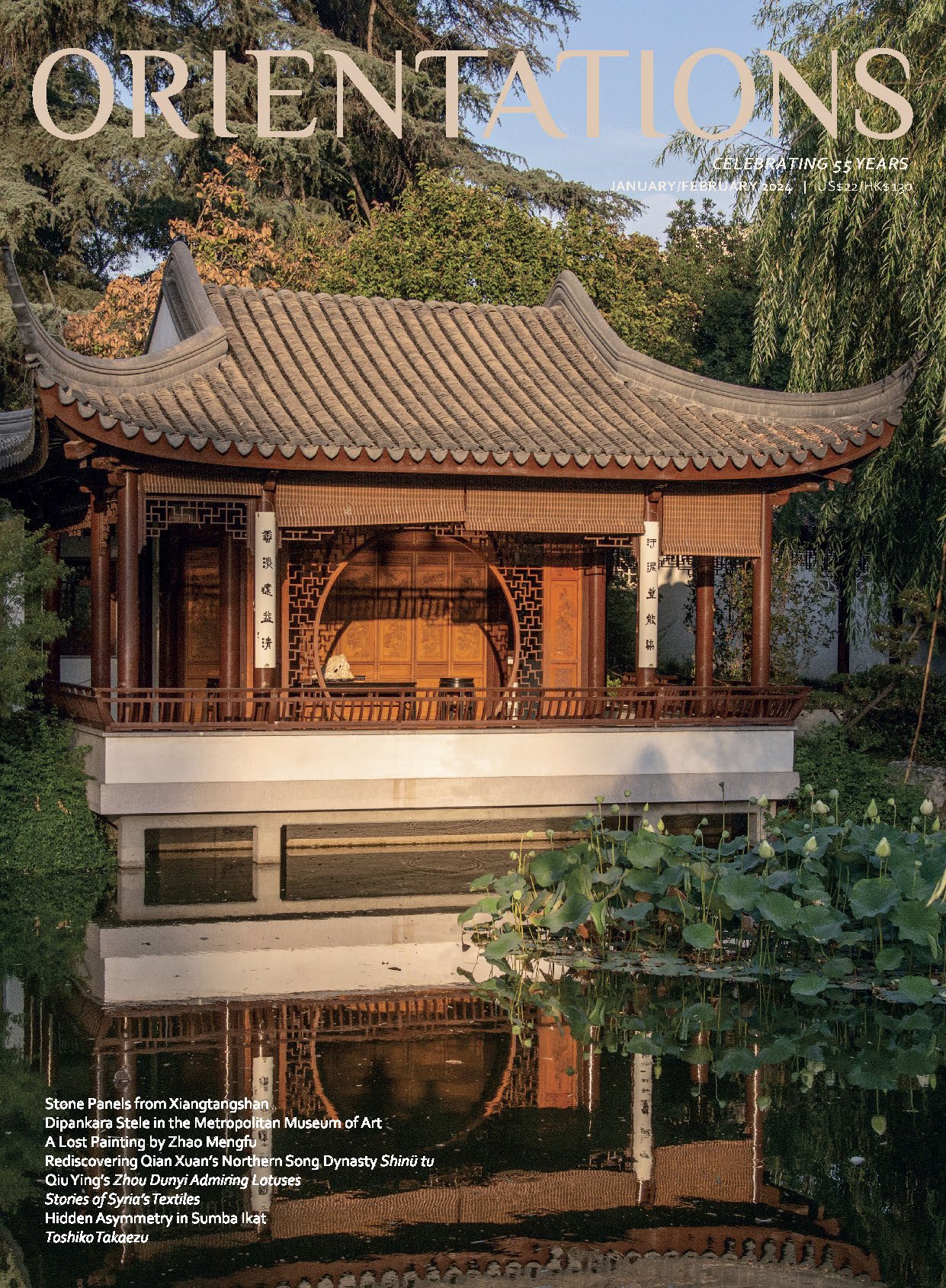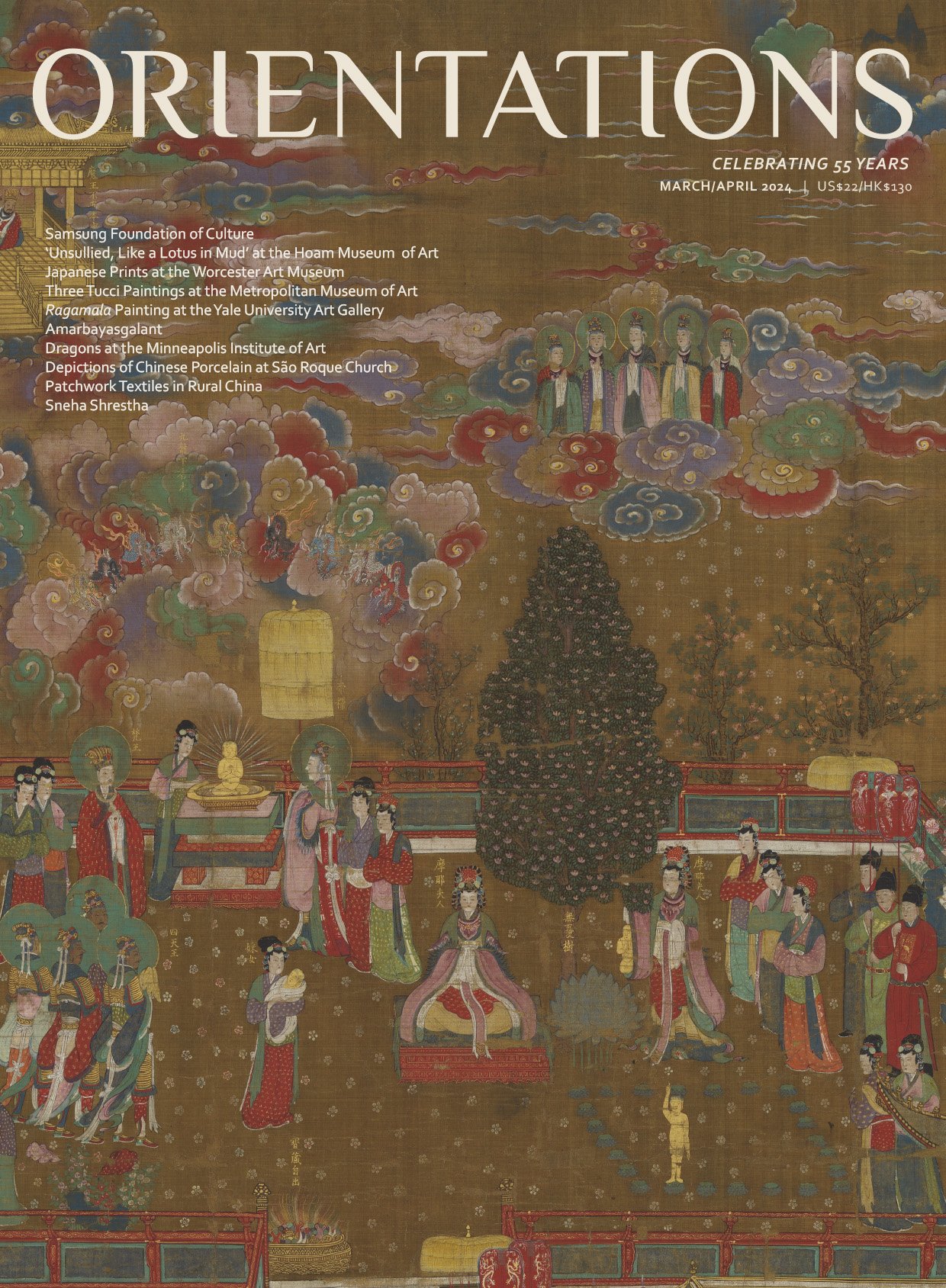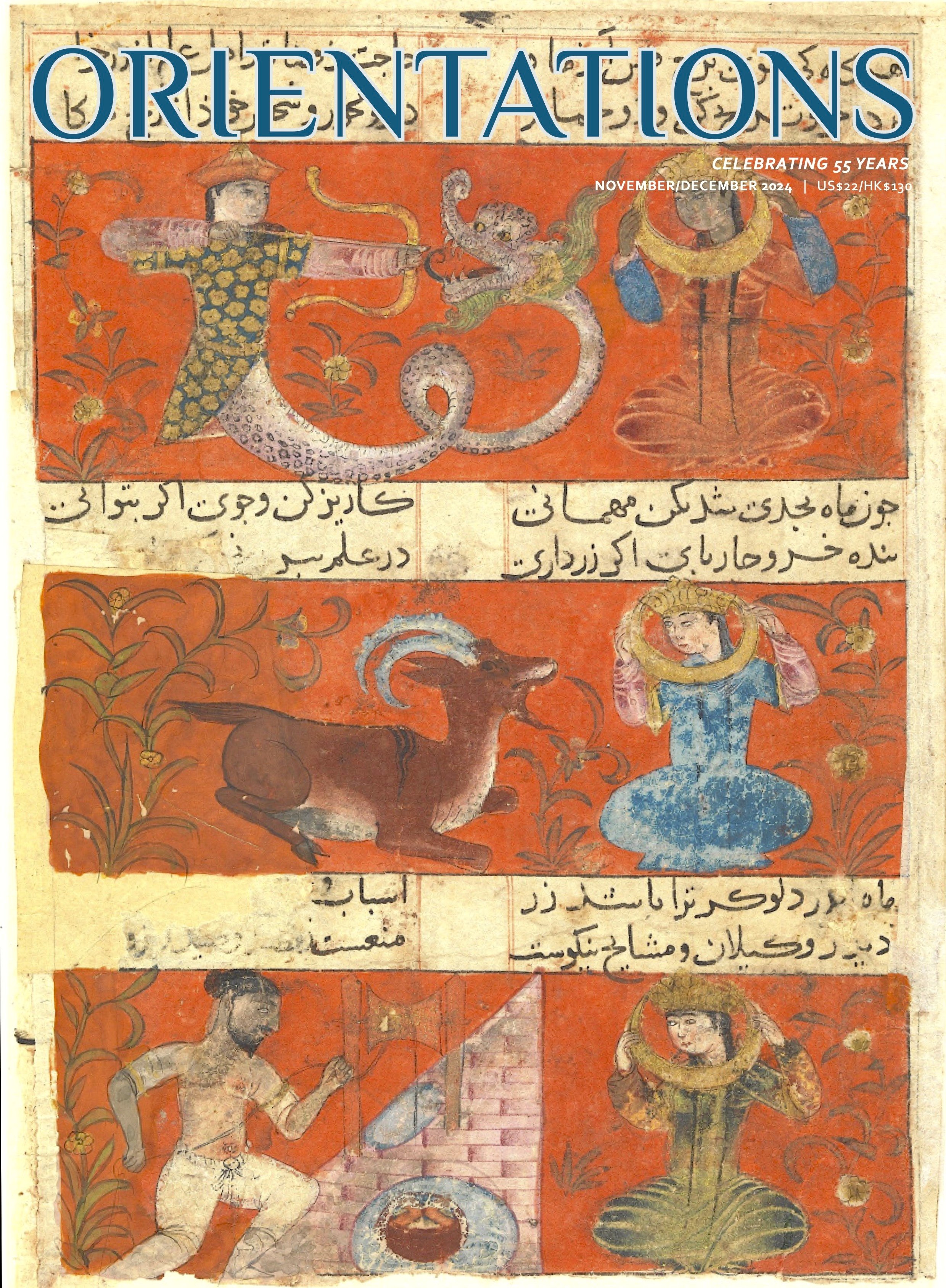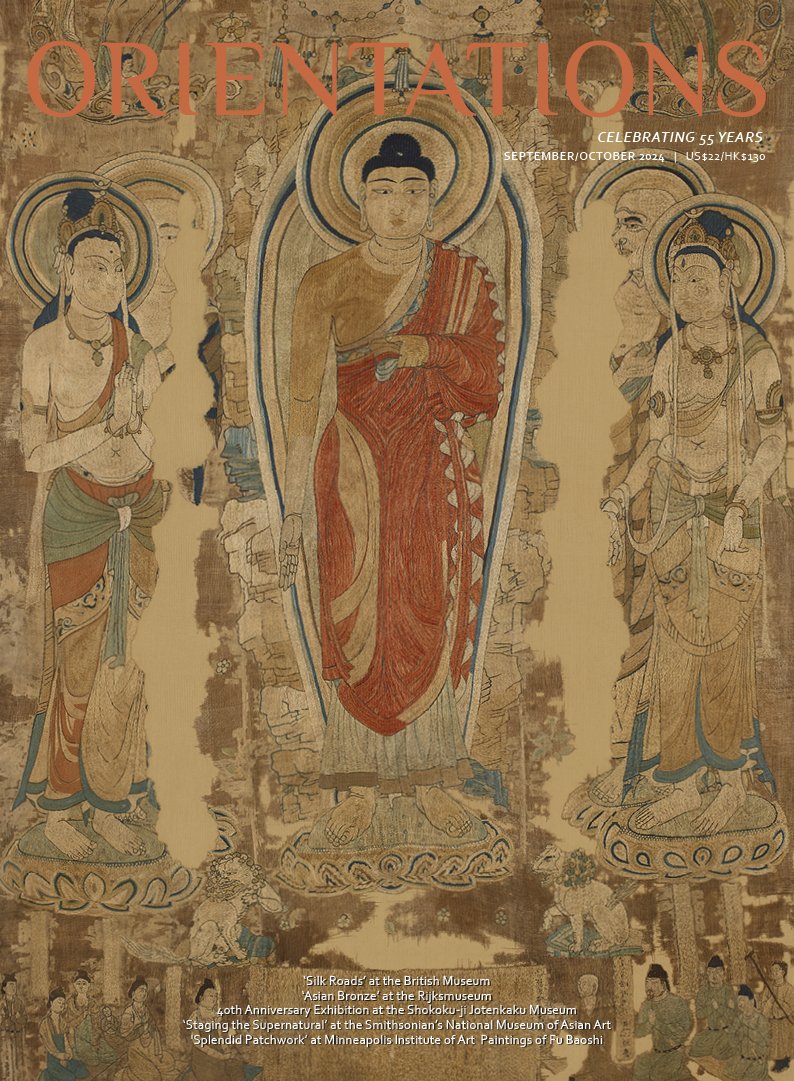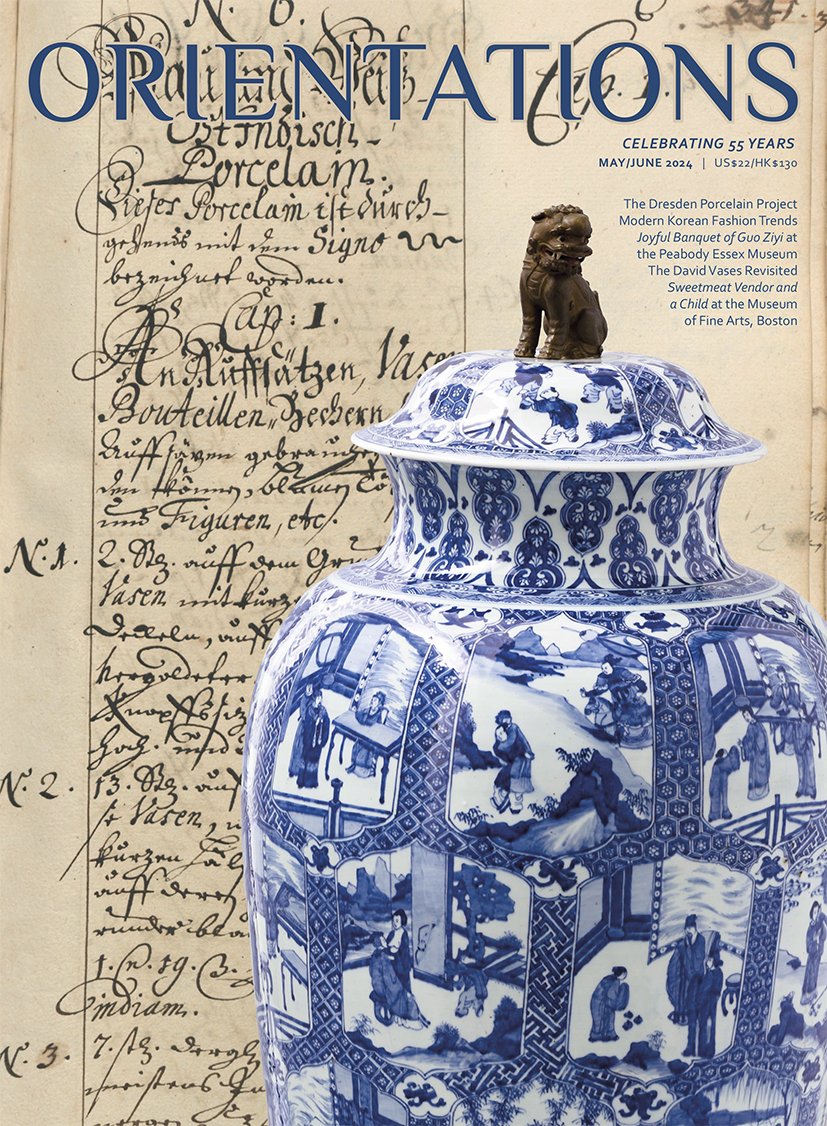JAN/FEB 2024
VOLUME 55 - NUMBER 1
Orientations is celebrating its 55th anniversary in 2024. Founded in 1969, it has evolved from a publication showcasing Asian art, culture, and travel to a magazine for collectors of Asian art with articles penned by leading museum curators and scholars from around the world. We continued to grow during the Covid-19 pandemic years with the launch of digital subscriptions—and now proudly boast a reach of almost 500,000 readers—as well as increased our custom publishing activities through OM Publishing. Most recently, we delved into our archives to add to our series of compendiums with the publication of Modern and Contemporary Ink Paintings, the first of the series to show the breadth of our coverage dedicated to contemporary art. Through collaboration with different partners—such as the Susan Chen Foundation with whom we have inaugurated the ‘Young Art Writers Award’, a competition for students, with the winning entry to be published by us—we hope to extend our impact beyond the pages of Orientations.
In the January/February issue, we look at stone carvings from China, in particular those from the Northern Qi (550–77) period Xiangtangshan Buddhist caves in Hebei, and their global dispersion. Seven ‘squatting monster caryatids’ previously eluding scholarly attention come under scrutiny for the first time. The Metropolitan Museum of Art houses a three-metre-tall inscribed Buddhist stele featuring an oversized Buddha and a cross-legged bodhisattva on two sides. Contextual analysis of the stele challenges previous notions about its provenance.
We present three articles on classical Chinese paintings. From the early Yuan dynasty, Zhao Mengfu’s (1254–1322) Song of the Playing Fields, rediscovered after centuries of obscurity, reflects the nostalgic sentiment of the artist, his contemplation of his aristocratic family’s accomplishments and failures. An album leaf in Taipei’s National Museum known as Ladies Cooling Off is commonly attributed to Qian Xuan (c. 1239–99) although it lacks his signature or seal. We examine the headdresses worn by the ladies in the painting and challenge this attribution. Lastly, we highlight a recent acquisition by The Huntington Library, Art Museum, and Botanical Gardens, a hanging scroll painted by the Ming artist Qiu Ying (c. 1494–c. 1552) entitled Zhou Dunyi Admiring Lotuses.
Also included are two articles on textiles. The first highlights the ‘Stories of Syria’s Textiles: Art and Heritage across Two Millennia’ exhibition at the Katonah Museum of Art showing the profound impact of textiles in Syrian culture throughout history. The second takes readers into the intricate world of Indonesian textiles, drawing attention to hinggi, a type of ikat men’s wrap from East Sumba long known for its biaxial symmetrical design.
We look forward to our next chapter, persevering with insightful articles that deepen understanding and foster appreciation for the richness of the arts of Asia and becoming more than just a magazine.
FEATURES
Jin Xu. Monsters on an Imperial Stone Base: Reconstructing Seven Stone Panels from Xiangtangshan
Fan Zhang. Dipankara Stele in the Metropolitan Museum of Art: Patronage, Provenance, and Politics
Richard M. Barnhart. Song of the Playing Fields: A Lost Painting by Zhao Mengfu Rediscovered
Bo Liu. Rediscovering a Rare Shinü tu from the Northern Song Dynasty: ‘Qian Xuan’s’ Ladies Cooling Off Redated
Phillip E. Bloom. Qiu Ying’s Zhou Dunyi Admiring Lotuses
Blair Fowlkes Childs. ‘Stories of Syria’s Textiles: Art and Heritage across Two Millennia’ at the Katonah Museum of Art
Peter ten Hoopen. Overlooked for a Century: Hidden Asymmetry in Sumba Ikat
Nonie Gadsden. ‘Toshiko Takaezu: Shaping Abstraction’ at the Museum of Fine Arts, Boston
REVIEW
Olivia Wang. ‘Liu Kuo-sung: Experimentation as Method’
VOLUME 55 - NUMBER 1
Orientations is celebrating its 55th anniversary in 2024. Founded in 1969, it has evolved from a publication showcasing Asian art, culture, and travel to a magazine for collectors of Asian art with articles penned by leading museum curators and scholars from around the world. We continued to grow during the Covid-19 pandemic years with the launch of digital subscriptions—and now proudly boast a reach of almost 500,000 readers—as well as increased our custom publishing activities through OM Publishing. Most recently, we delved into our archives to add to our series of compendiums with the publication of Modern and Contemporary Ink Paintings, the first of the series to show the breadth of our coverage dedicated to contemporary art. Through collaboration with different partners—such as the Susan Chen Foundation with whom we have inaugurated the ‘Young Art Writers Award’, a competition for students, with the winning entry to be published by us—we hope to extend our impact beyond the pages of Orientations.
In the January/February issue, we look at stone carvings from China, in particular those from the Northern Qi (550–77) period Xiangtangshan Buddhist caves in Hebei, and their global dispersion. Seven ‘squatting monster caryatids’ previously eluding scholarly attention come under scrutiny for the first time. The Metropolitan Museum of Art houses a three-metre-tall inscribed Buddhist stele featuring an oversized Buddha and a cross-legged bodhisattva on two sides. Contextual analysis of the stele challenges previous notions about its provenance.
We present three articles on classical Chinese paintings. From the early Yuan dynasty, Zhao Mengfu’s (1254–1322) Song of the Playing Fields, rediscovered after centuries of obscurity, reflects the nostalgic sentiment of the artist, his contemplation of his aristocratic family’s accomplishments and failures. An album leaf in Taipei’s National Museum known as Ladies Cooling Off is commonly attributed to Qian Xuan (c. 1239–99) although it lacks his signature or seal. We examine the headdresses worn by the ladies in the painting and challenge this attribution. Lastly, we highlight a recent acquisition by The Huntington Library, Art Museum, and Botanical Gardens, a hanging scroll painted by the Ming artist Qiu Ying (c. 1494–c. 1552) entitled Zhou Dunyi Admiring Lotuses.
Also included are two articles on textiles. The first highlights the ‘Stories of Syria’s Textiles: Art and Heritage across Two Millennia’ exhibition at the Katonah Museum of Art showing the profound impact of textiles in Syrian culture throughout history. The second takes readers into the intricate world of Indonesian textiles, drawing attention to hinggi, a type of ikat men’s wrap from East Sumba long known for its biaxial symmetrical design.
We look forward to our next chapter, persevering with insightful articles that deepen understanding and foster appreciation for the richness of the arts of Asia and becoming more than just a magazine.
FEATURES
Jin Xu. Monsters on an Imperial Stone Base: Reconstructing Seven Stone Panels from Xiangtangshan
Fan Zhang. Dipankara Stele in the Metropolitan Museum of Art: Patronage, Provenance, and Politics
Richard M. Barnhart. Song of the Playing Fields: A Lost Painting by Zhao Mengfu Rediscovered
Bo Liu. Rediscovering a Rare Shinü tu from the Northern Song Dynasty: ‘Qian Xuan’s’ Ladies Cooling Off Redated
Phillip E. Bloom. Qiu Ying’s Zhou Dunyi Admiring Lotuses
Blair Fowlkes Childs. ‘Stories of Syria’s Textiles: Art and Heritage across Two Millennia’ at the Katonah Museum of Art
Peter ten Hoopen. Overlooked for a Century: Hidden Asymmetry in Sumba Ikat
Nonie Gadsden. ‘Toshiko Takaezu: Shaping Abstraction’ at the Museum of Fine Arts, Boston
REVIEW
Olivia Wang. ‘Liu Kuo-sung: Experimentation as Method’
VOLUME 55 - NUMBER 1
Orientations is celebrating its 55th anniversary in 2024. Founded in 1969, it has evolved from a publication showcasing Asian art, culture, and travel to a magazine for collectors of Asian art with articles penned by leading museum curators and scholars from around the world. We continued to grow during the Covid-19 pandemic years with the launch of digital subscriptions—and now proudly boast a reach of almost 500,000 readers—as well as increased our custom publishing activities through OM Publishing. Most recently, we delved into our archives to add to our series of compendiums with the publication of Modern and Contemporary Ink Paintings, the first of the series to show the breadth of our coverage dedicated to contemporary art. Through collaboration with different partners—such as the Susan Chen Foundation with whom we have inaugurated the ‘Young Art Writers Award’, a competition for students, with the winning entry to be published by us—we hope to extend our impact beyond the pages of Orientations.
In the January/February issue, we look at stone carvings from China, in particular those from the Northern Qi (550–77) period Xiangtangshan Buddhist caves in Hebei, and their global dispersion. Seven ‘squatting monster caryatids’ previously eluding scholarly attention come under scrutiny for the first time. The Metropolitan Museum of Art houses a three-metre-tall inscribed Buddhist stele featuring an oversized Buddha and a cross-legged bodhisattva on two sides. Contextual analysis of the stele challenges previous notions about its provenance.
We present three articles on classical Chinese paintings. From the early Yuan dynasty, Zhao Mengfu’s (1254–1322) Song of the Playing Fields, rediscovered after centuries of obscurity, reflects the nostalgic sentiment of the artist, his contemplation of his aristocratic family’s accomplishments and failures. An album leaf in Taipei’s National Museum known as Ladies Cooling Off is commonly attributed to Qian Xuan (c. 1239–99) although it lacks his signature or seal. We examine the headdresses worn by the ladies in the painting and challenge this attribution. Lastly, we highlight a recent acquisition by The Huntington Library, Art Museum, and Botanical Gardens, a hanging scroll painted by the Ming artist Qiu Ying (c. 1494–c. 1552) entitled Zhou Dunyi Admiring Lotuses.
Also included are two articles on textiles. The first highlights the ‘Stories of Syria’s Textiles: Art and Heritage across Two Millennia’ exhibition at the Katonah Museum of Art showing the profound impact of textiles in Syrian culture throughout history. The second takes readers into the intricate world of Indonesian textiles, drawing attention to hinggi, a type of ikat men’s wrap from East Sumba long known for its biaxial symmetrical design.
We look forward to our next chapter, persevering with insightful articles that deepen understanding and foster appreciation for the richness of the arts of Asia and becoming more than just a magazine.
FEATURES
Jin Xu. Monsters on an Imperial Stone Base: Reconstructing Seven Stone Panels from Xiangtangshan
Fan Zhang. Dipankara Stele in the Metropolitan Museum of Art: Patronage, Provenance, and Politics
Richard M. Barnhart. Song of the Playing Fields: A Lost Painting by Zhao Mengfu Rediscovered
Bo Liu. Rediscovering a Rare Shinü tu from the Northern Song Dynasty: ‘Qian Xuan’s’ Ladies Cooling Off Redated
Phillip E. Bloom. Qiu Ying’s Zhou Dunyi Admiring Lotuses
Blair Fowlkes Childs. ‘Stories of Syria’s Textiles: Art and Heritage across Two Millennia’ at the Katonah Museum of Art
Peter ten Hoopen. Overlooked for a Century: Hidden Asymmetry in Sumba Ikat
Nonie Gadsden. ‘Toshiko Takaezu: Shaping Abstraction’ at the Museum of Fine Arts, Boston
REVIEW
Olivia Wang. ‘Liu Kuo-sung: Experimentation as Method’

